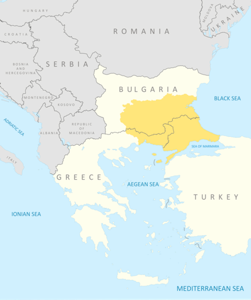Thraex

Map of south-eastern Europe, showing ancient Thrace in dark yellow over the borders of the modern States of Bulgaria, Greece, and Turkey. Thrace became Roman province in 44 CE. In Antiquity thrace was thought to be the homeland of the gods Apollo and Dionysos, and according to Homer it was the „golden realm of Orpheus“. Thrace was also famous for its philosophers, and the Carpathian mountains were thoght to be home of the mythical Griffons, the head of the Griffon is also constituting the distinctive element on a thraex gladiator´s helmet. Also the chariot of the goddess Nemesis, closely related to the Gladiators and Gladiator games, was thought to be drawn by Griffons.
He produced some decayed twopenny-halfpenny gladiators, who would have fallen flat if you breathed on them; I have seen better ruffians turned in to fight the wild beasts. He shed the blood of some mounted infantry that might have come off a lamp; dunghill cocks you would have called them: one a spavined mule, the other bandylegged, and the holder of the bye, just one corpse instead of another, and hamstrung. One man, a Thracian, had some stuffing, but he too fought according to the rule of the schools. In short, they were all flogged afterwards. How the great crowd roared at them, Lay it on'!
Petronius, Satyricon, 45.
A full thraex kit consists of the following items:
AER/1502 Thraex Helmet, bronze
AER/1502-TN Thraex Helmet, tinned steel
AER/AS/1502-GR Thraex /Hoplomachus Greaves, bronze
AER/AS/1502-GR-TN Thraex /Hoplomachus Greaves, tinned steel
AER/CL/1501-LB Textile Armour Right Arm
AER/CL/1502- (size)-N Textile Armour Trouser
AER/MISC/1503 Gladiator Belt
AER/SWS/1503 Thraex sica
AER/CL/1504-STD-WL Subligaculum
Pompeji, before 79 AD
17. Januar 2012


Type: heavyly armoured swordfighter
Opponents: murmillo, hoplomachus
Weapon: Bent or curved short sword (sica)
Armour: Attic‐Boeotian helmet, small rectangular shield (scutum, or parmula), textile right arm guard (manica), textile armour trouseres and high greaves (ocreae)
Total weight of equipment: 15‐18 kg
The thraex armamtura probably came into being during the frist century BCE, when Rome undertook several military campaigns in the Balkans. Among the captured enemy soldiers were many Thracians, who later fought as gladiators in the Roman arenes: the thraeces. But also slaves captured from elsewhere later fought in this armatura.